
An explosive is a reactive substance that contains a great amount of potential energy that can produce an explosion if released suddenly, usually accompanied by the production of light, heat, sound, and pressure. An explosive charge is a measured quantity of explosive material, which may either be composed solely of one ingredient or be a mixture containing at least two substances.
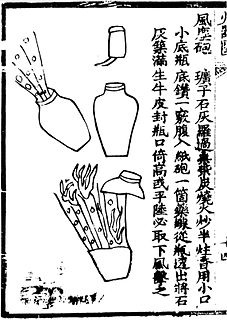
A bomb is an explosive weapon that uses the exothermic reaction of an explosive material to provide an extremely sudden and violent release of energy. Detonations inflict damage principally through ground- and atmosphere-transmitted mechanical stress, the impact and penetration of pressure-driven projectiles, pressure damage, and explosion-generated effects. Bombs have been utilized since the 11th century starting in East Asia.

Ammonium nitrate is a chemical compound with the chemical formula NH4NO3. It is a white crystalline salt consisting of ions of ammonium and nitrate. It is highly soluble in water and hygroscopic as a solid, although it does not form hydrates. It is predominantly used in agriculture as a high-nitrogen fertilizer. Global production was estimated at 21.6 million tonnes in 2017.
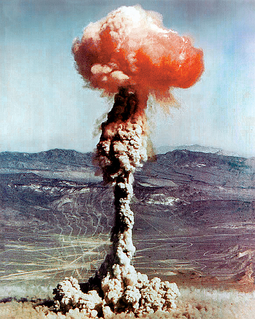
The effects of a nuclear explosion on its immediate vicinity are typically much more destructive and multifaceted than those caused by conventional explosives. In most cases, the energy released from a nuclear weapon detonated within the lower atmosphere can be approximately divided into four basic categories:

"Duck and cover" is a method of personal protection against the effects of a nuclear explosion. Ducking and covering is useful in offering a degree of protection to personnel located outside the radius of the nuclear fireball but still within sufficient range of the nuclear explosion that standing upright and uncovered is likely to cause serious injury or death. In the most literal interpretation, the focus of the maneuver is primarily on protective actions one can take during the first few crucial seconds-to-minutes after the event, while the film of the same name and a full encompassing of the advice also cater to providing protection up to weeks after the event.
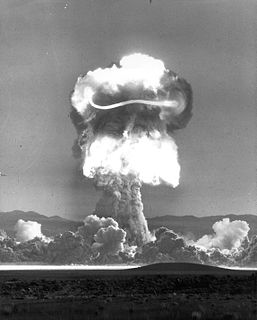
Operation Plumbbob was a series of nuclear tests that were conducted between May 28 and October 7, 1957, at the Nevada Test Site, following Project 57, and preceding Project 58/58A.
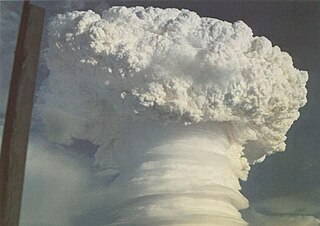
Operation Hardtack I was a series of 35 nuclear tests conducted by the United States from April 28 to August 18 in 1958 at the Pacific Proving Grounds. At the time of testing, the Operation Hardtack I test series included more nuclear detonations than the total of prior nuclear explosions in the Pacific Ocean. These tests followed the Project 58/58A series, which occurred from 1957 December 6 to 1958, March 14, and preceded the Operation Argus series, which took place in 1958 from August 27 to September 6.
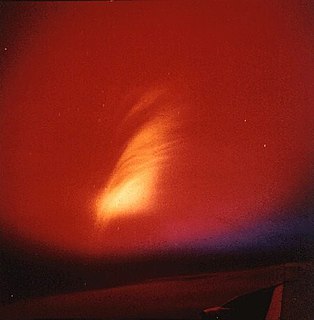
Operation Fishbowl was a series of high-altitude nuclear tests in 1962 that were carried out by the United States as a part of the larger Operation Dominic nuclear test program. Flight-test vehicles were designed and manufactured by Avco Corporation.

Minor Scale was a test conducted on June 27, 1985, by the United States Defense Nuclear Agency involving the detonation of several thousand tons of conventional explosives to simulate the explosion of a small nuclear bomb. The purpose of the test was to evaluate the effect of nuclear blasts on various pieces of military hardware, particularly new, blast-hardened launchers for the MGM-134 Midgetman ballistic missile.

Explosives safety originated as a formal program in the United States in the aftermath of World War I when several ammunition storage areas were destroyed in a series of mishaps. The most serious occurred at Picatinny Arsenal Ammunition Storage Depot, New Jersey, in July, 1926 when an electrical storm led to fires that caused explosions and widespread destruction. The severe property damage and 19 fatalities led Congress to empower a board of Army and Naval officers to investigate the Picatinny Arsenal disaster and determine if similar conditions existed at other ammunition depots. The board reported in its findings that this mishap could recur, prompting Congress to establish a permanent board of colonels to develop explosives safety standards and ensure compliance beginning in 1928. This organization evolved into the Department of Defense Explosives Safety Board (DDESB) and is chartered in Title 10 of the US Code. The DDESB authors Defense Explosives Safety Regulation (DESR) 6055.9 which establishes the explosives safety standards for the Department of Defense. The DDESB also evaluates scientific data which may adjust those standards, reviews and approves all explosives site plans for new construction, and conducts worldwide visits to locations containing US title munitions. The cardinal principle of explosives safety is expose the minimum number of people for the minimum time to the minimum amount of explosives.
Divine Strake was the official designation for a large-yield, non-nuclear, high-explosive test that was planned for the Nevada National Security Site, formerly the Nevada Test Site. Following its announcement, the test generated great controversy, centering on two issues: its potential value in developing a nuclear "bunker buster" warhead, and the possibility that the mushroom cloud generated by the explosion could carry large amounts of radioactive dust deposited at the Test Site over years of nuclear testing.

TNT equivalent is a convention for expressing energy, typically used to describe the energy released in an explosion. The tonne of TNT is a unit of energy defined by that convention to be 4.184 gigajoules, which is the approximate energy released in the detonation of a metric ton of TNT. In other words, for each gram of TNT exploded, 4.184 kilojoules of energy is released.

Operation Sailor Hat was a series of explosives effects tests, conducted by the United States Navy Bureau of Ships under the sponsorship of the Defense Atomic Support Agency. The tests consisted of two underwater explosions at San Clemente Island, California in 1964 and three surface explosions at Kahoʻolawe, Hawaii in 1965. They were non-nuclear tests employing large quantities of conventional explosives to determine the effects of a nuclear weapon blast on naval vessels, and the first major test of this kind since Operation Crossroads in July 1946.
The United States's Cornerstone nuclear test series was a group of 11 nuclear tests conducted in 1988–1989. These tests followed the Operation Touchstone series and preceded the Operation Aqueduct series.
The United States's Sculpin nuclear test series was a group of 7 nuclear tests conducted between October 1990 and September 1991. These tests followed the Operation Aqueduct series and preceded the Operation Julin series.

Operation Julin was a group of 7 nuclear tests conducted by the United States in 1991–1992. These tests followed the Operation Sculpin series, and were the last before negotiations began for the Comprehensive Test Ban Treaty.
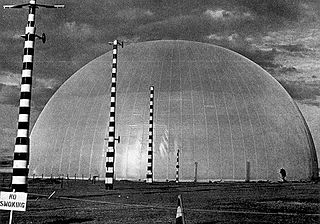
Operation Distant Plain was a series of non-nuclear explosive and detonable gas tests performed on test sites in Alberta, Canada, during the course of 1966 and 1967. Their purpose was to provide airblast, cratering, and ground shock data in summer and winter conditions for testing new prototype equipment, military targets and coniferous forest blowdown, and defoliation.
A sympathetic detonation, also called flash over or secondary/secondaries (explosion), is a detonation, usually unintended, of an explosive charge by a nearby explosion.
Project 57 was an open-air nuclear test conducted by the United States at the Nellis Air Force Range in 1957, following Operation Redwing, and preceding Operation Plumbbob. The test area, also known as Area 13, was a 10 miles (16 km) by 16 miles (26 km) block of land abutting the northeast boundary of the Nevada National Security Site.

Operation Prairie Flat was a test involving the detonation of a 500-short-ton (450 t) spherical surface charge of TNT to evaluate airblast, ground shock and thermal effects of nuclear weapons.
















